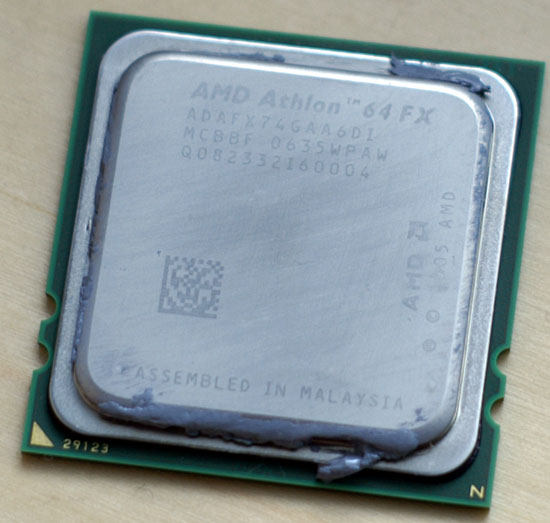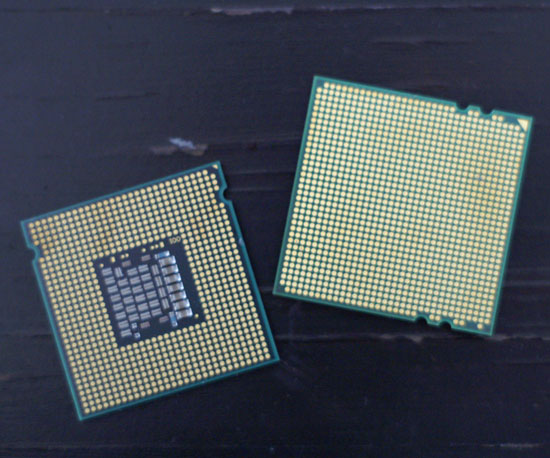AMD's Quad FX: Technically Quad Core
by Anand Lal Shimpi on November 30, 2006 1:16 PM EST- Posted in
- CPUs
The Processors
To complete the brand new Quad FX platform AMD is introducing three new processors today: the Athlon 64 FX-74, FX-72 and FX-70, running at 3.0GHz, 2.8GHz and 2.6GHz respectively. Each physical processor features two cores and a 1MB L2 cache per core, much like previous dual core FX processors, but what sets these CPUs apart from previous FX chips is that they are sold in bundles of two. So when you buy an Athlon 64 FX-74, you are actually buying two dual-core CPUs in a single box. It's not the most elegant way of getting four cores, but it gets the job done and AMD manages to do so at a competitive price. Note that these CPUs are effectively Opterons but with the memory controller configured to support un-buffered DDR2.

The Chip

Core 2 Duo (left) vs. Athlon 64 FX-74 (right), AMD's first LGA desktop CPU
AMD's pricing structure, including the new Quad FX processors, is as follows, with Intel's upper echelon CPUs thrown in for comparison:
| CPU | Clock Speed | L2 Cache | Price |
| AMD Athlon 64 FX-74* | 3.0GHz | 1MB per core | $999 |
| AMD Athlon 64 FX-72* | 2.8GHz | 1MB per core | $799 |
| AMD Athlon 64 FX-70* | 2.6GHz | 1MB per core | $599 |
| AMD Athlon 64 FX-62 | 2.8GHz | 1MB per core | $713 |
| AMD Athlon 64 X2 5200+ | 2.6GHz | 1MB per core | $403 |
| Intel Core 2 Extreme QX6700 | 2.66GHz | 4MB per 2 cores | $999 |
| Intel Core 2 Quad Q6600** | 2.40GHz | 4MB per 2 cores | $851 |
| Intel Core 2 Extreme X6800 | 2.93GHz | 4MB | $999 |
| Intel Core 2 Duo E6700 | 2.66GHz | 4MB | $530 |
* Note: These processors come in pairs of two, pricing is for both CPUs
** Note: The Core 2 Quad Q6600 is an unreleased CPU and will be introduced in January 2007.
So for $999 you can either get two dual core 3.0GHz AMD processors, or a single quad core 2.66GHz Core 2 Extreme QX6700. Later we'll figure out which is indeed faster but it seems that AMD's pricing is at least competitive.
The Roadmap
When we first heard that Quad FX wasn't going to be Socket-AM2, we couldn't help but feel that AMD was introducing yet another Socket-940 into the mix. Is there really a future for Quad FX or is it nothing more than a stop-gap solution until native quad-core CPUs arrive?

The Socket
AMD has already committed to supporting two quad-core CPUs in current Quad FX platforms, so there's at least an upgrade path well into 2007, but what happens afterwards?
AMD's most recent roadmaps show continued support for Quad FX throughout 2007; in fact, the highest clock speed AMD CPUs will always be Socket-1207 parts (3.0GHz today and then 3.2GHz by Q2 '07). It looks like AMD is transitioning the Athlon 64 FX line to be exclusively for the Quad FX platform, leaving all other chips for AM2.










88 Comments
View All Comments
Viditor - Thursday, November 30, 2006 - link
If they can...
The 680a chipset has a direct HT link to each MCP, the 680i obviously can't do that and must bridge through the SPP.
Now if only we could find a review that actually showed that...;)
Seriously, the one major benefit of Quad FX is that it can run 4 GPUs. While I appreciate all of the conjecture and speculation, it isn't really a test of the facts, is it?
defter - Friday, December 1, 2006 - link
<quote>Seriously, the one major benefit of Quad FX is that it can run 4 GPUs.</quote>How that's a benefit? You can have 8 GPUs in a same system (AMD or Intel based, it doesn't matter) with a couple of NVIDIA Quadro Plex 1000 Model II's if money isn't an issue:
http://www.nvidia.com/page/quadroplex_comparison_c...">http://www.nvidia.com/page/quadroplex_comparison_c...
JarredWalton - Friday, December 1, 2006 - link
Fact: Quad SLI (7950 GX2) works on 590 SLI and 680i.Fact: Quad SLI (8800 GTX) does not exist.
Until the second item changes, we only have the first to go on, which is that current quad SLI works - at least as much as it works anywhere - on both platforms. And the QSLI drivers are still largely broken - you can run benchmarks, but as soon as you start playing lots of games rather than just benching, problems crop up. Neverwinter Nights 2 for example doesn't even run properly with CrossFire or SLI, so let's not even worry about getting QSLI support for now.
JackPack - Thursday, November 30, 2006 - link
8800 GTX requies two slots, which means it won't fit in the 4x4 motherboard. Quad-SLI performance has already shown to be poor using two 7950 GX2 cards. Finally, how do you bridge four 8800 cards together?Viditor - Thursday, November 30, 2006 - link
Huh?
http://www.bit-tech.net/hardware/2006/11/08/nvidia...">Single slot 8800 GTX
This is only when using a single MCP, the 680a uses dual MCPs.
The 680i uses one MCP and one SPP.
By having 2 sets of bridges (one bridge per MCP).
JarredWalton - Friday, December 1, 2006 - link
Quad SLI has problems whether or not you have dual MCPs. It's driver and software related - basically the drivers don't do AFR on a lot of titles and so you end up with lower than 7900 GTX SLI performance.As for two slots, they're talking the width of the cards. They only plug into one slot, but they fill the adjacent slot. Quad 8800 GTX would require eight expansion slots right now. Given that Vista 8800 drivers aren't even out yet, I think NVIDIA has other things to do before they worry about moving beyond SLI'ed 8800 cards.
PrinceGaz - Thursday, November 30, 2006 - link
I suppose you could replace the HSF with something smaller which would fit in a single-slot, which would have to mean water-cooling.Quad-SLI performance (or lack of) is probably a driver-issue.
Don't 8800 cards have two SLI sockets therefore allowing you to chain together as many as you like (in theory)?
casket - Thursday, November 30, 2006 - link
It appears with win-xp sp2... this quad fx stinks. How about Win 2003 or Vista Ultimate? It might change things drastically.Neosis - Thursday, November 30, 2006 - link
I don't think the problems in the benchmarks are not an opperating system issue. Two processors having totally four cores are not the same as a processor having the same number of cores. Additional latencies will slow down the performance.Viditor - Thursday, November 30, 2006 - link
Actually, they probably are...Windows XP is not NUMA aware, while Vista is.
In this case there is no difference...the Kentsfield has exactly the same latency as a 2 socket dual core because the 2 dual cores on-board don't talk directly with each other.